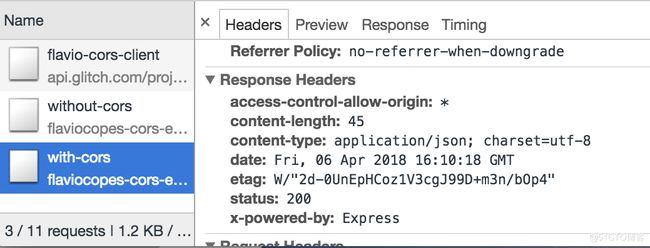How to allow cross site requests by setting up CORS
A JavaScript application running in the browser can usually only access HTTP resources from the same domain (origin) that serves them.
Loading images or scripts/styles from the same origin always works. Also, loading Web Fonts using @font-face have the ‘same-origin’ policy set by default. Likewise with other, less popular things (like WebGL textures and drawImage resources loaded in the Canvas API).
However, XHR and Fetch calls to an external, 3rd party server will fail. That is unless the 3rd party server implements a mechanism which allows the connection to be made and requested resources to be downloaded and used.
This mechanism is called CORS, Cross-Origin Resource Sharing.
One very important thing that needs CORS is ES Modules, recently introduced in modern browsers.
If you don’t set up a CORS policy on the server that allows it to serve 3rd party origins, the request will fail.
A Cross-Origin resource fails if it’s:
- to a differentdomain
- to a differentsubdomain
- to a differentport
- to a differentprotocol
CORS is there for your security, to prevent malicious users from exploiting whatever Web Platform you happen to be using.
If you control both the server and the client, you know that both parties are trustworthy, and therefore have good reason to allow resource sharing.
How?
It depends on your server-side stack.
Example with Express
If you are using Node.js and Express as a framework, use the CORS middleware package.
Here’s a simple implementation of an Express Node.js server:
const express = require('express')
const app = express()
app.get('/without-cors', (req, res, next) => {
res.json({ msg: ' no CORS, no party!' })
})
const server = app.listen(3000, () => {
console.log('Listening on port %s', server.address().port)
})If you hit /without-cors with a fetch request from a different origin, it’s going to raise the CORS issue.
All you need to do to make things work smoothly, is to require the cors package linked above, and pass it in as a middleware function to an endpoint request handler:
const express = require('express')
const cors = require('cors')
const app = express()
app.get('/with-cors', cors(), (req, res, next) => {
res.json({ msg: 'WHOAH with CORS it works! ' })
})
/* the rest of the app */I made a simple Glitch example, here’s its code: https://glitch.com/edit/#!/flavio-cors-client.
This is the Node.js Express server: https://glitch.com/edit/#!/flaviocopes-cors-example-express
Note how the request that fails because the server does not handle the CORS headers correctly, is still received. As you can see in the Network panel, where you can see a message the server sent:
Allow only specific origins
This example has a problem however: ANY request will be accepted by the server as cross-origin.
As you can see in the Network panel, the request that passed has a response header access-control-allow-origin: *:
You need to configure the server to only allow one origin to serve, and block all the others.
Using the same cors Node library, here’s how you would do it:
const cors = require('cors')
const corsOptions = {
origin: 'https://yourdomain.com',
}
app.get('/products/:id', cors(corsOptions), (req, res, next) => {
//...
})You can serve more as well: 可以通过这种方法方实现的更灵活,譬如允许多个域:
const whitelist = ['http://example1.com', 'http://example2.com']
const corsOptions = {
origin: function (origin, callback) {
if (whitelist.indexOf(origin) !== -1) {
callback(null, true)
} else {
callback(new Error('Not allowed by CORS'))
}
},
}Preflight
There are some requests that are handled in a “simple” way. All GET requests belong to this group.
Also some POST and HEAD requests do as well.
POST requests are also in this group, if they satisfy the requirement of using a Content-Type of
-
application/x-www-form-urlencoded -
multipart/form-data -
text/plain
All other requests must run through a pre-approval phase, called preflight. The browser does this to determine if it has the permission to perform an action, by issuing an OPTIONS request.
A preflight request contains a few headers that the server will use to check permissions (irrelevant fields omitted):
OPTIONS /the/resource/you/request
Access-Control-Request-Method: POST
Access-Control-Request-Headers: origin, x-requested-with, accept
Origin: https://your-origin.comThe server will respond with something like this (irrelevant fields omitted):
HTTP/1.1 200 OK
Access-Control-Allow-Origin: https://your-origin.com
Access-Control-Allow-Methods: POST, GET, OPTIONS, DELETEWe checked for POST, but the server tells us we can also issue other HTTP request types for that particular resource.
Following the Node.js Express example above, the server must also handle the OPTIONS request:
var express = require('express')
var cors = require('cors')
var app = express()
//allow OPTIONS on just one resource
app.options('/the/resource/you/request', cors())
//allow OPTIONS on all resources
app.options('*', cors())
